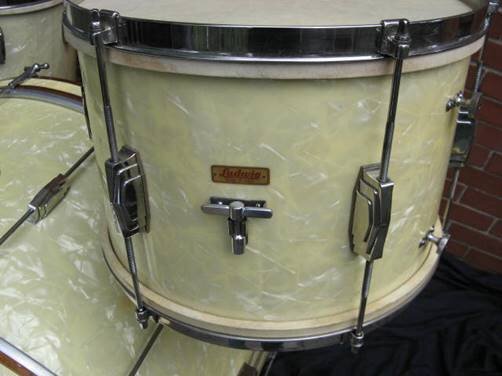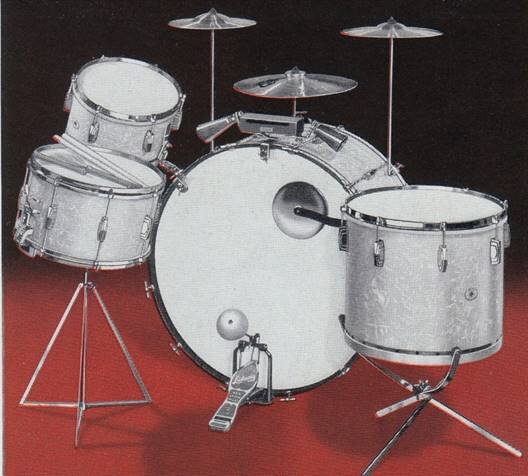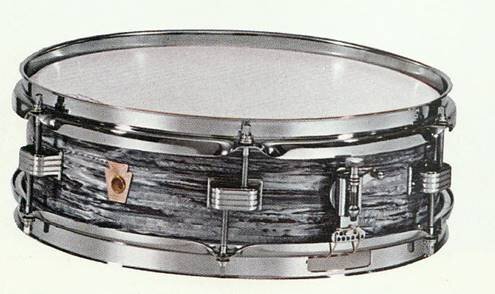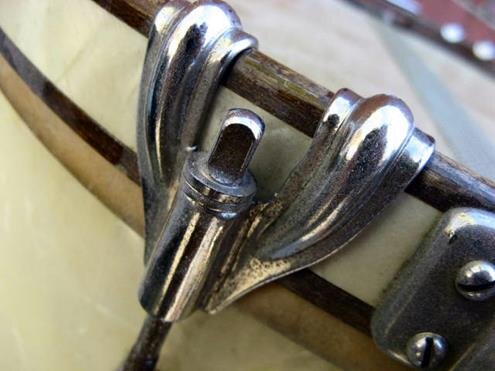LUDWIG LUGS
1923-1965
Like most other drum companies during the early 1920’s, The Ludwig & Ludwig Drum Company used standard tubular lugs on their snare drums.
Bass drums of the 1920’s and early 1930’s used long tube lugs as well as single and double center support studs.
During the 1930’s, a somewhat primitive lug was used on tom toms
The use of tube lugs would remain unchanged until 1935-1936, when Ludwig (now owned by G.C. Conn) introduced their new “Imperial” or “Streamline” snare drum lug casing. Considered by many to be the most elegant lug ever designed, the Imperial tension casing incorporated a beautiful and majestic art deco design. Like the original Slingerland Streamline lug, it too had the threads tapped directly into the metal casing and suffered from the same thread design flaw as the Slingerland Streamline lug from that era. Ludwig & Ludwig still used the aforementioned tom tom lugs until around 1939. The Imperial lugs were not incorporated into bass drum design until around 1937-1938.
1936 Ludwig & Ludwig Catalog showing the Imperial lug
1936 Ludwig & Ludwig Silver Anniversary model
This unbelievably rare snare drum is an engraved Deluxe version of the Silver Anniversary model.
From the Mike Curotto collection
Nickel plated version
By 1937, the lug was given an internal spring and swivel inserts similar to those of Slingerland and Leedy. This beautiful lug would see continual use throughout the next decade and a very similar version is still in use today.
1937 Ludwig & Ludwig Imperial Lug with threaded inserts and spring
The Imperial lug was also used on bass drums and tom toms in the late 1930’s. Single as well as double ended lugs were offered. A backing plate was usually installed between the lug and the shell. Bass drums were equipped with either standard length lugs or extra long versions.
A very long, double ended version of the Imperial lug was also offered for Ludwig’s top of the line bass drums starting around 1937. (This long lug was still in use in the 1960’s-70’s on concert models)
1930’s extra long Ludwig & Ludwig Imperial bass drum lug
Center support studs were still used on some single tension bass drum models like the Artist’s Model and Pioneer Model.
“PLASTIC” LUGS
In 1939, Ludwig & Ludwig experimented with Bake-Lite (early plastic) lugs on their “Modern Bi-Tone drums”. These lugs came in a few different colors and contained metal interior parts. The Bake-Lite outer cover was just a façade. The Bake-Lite lug was quite fragile and this “experiment” did not last long! Very few examples exist today.
1939-1941 Bi-Tone Bake-Lite lug
MODERN BI-TONE DRUM SET
Around 1940, a new lug was designed and was offered as a less expensive option. This lug was called the Airline Tension Casing and was also used by Leedy during the same time. It was used on Timbales, and single headed tom toms. Leedy used the Airline casing on some snare drum models (see Leedy Lugs).
AIRLINE TENSION CASING
1940-41 CATALOG
World War Two and Ludwig & Ludwig
Like Slingerland and Leedy, Ludwig & Ludwig had to adapt to the WWII metal restriction order and produced some interesting drums during that period. The “Victory” line was launched featuring solid maple lugs.
1943 Ludwig & Ludwig Victory Models with wooden lugs and hoops
For more information on drums made during World War Two, please visit: WWII DRUMS
……………………………………………………………………………………………………………………………………………………………………………………………………………………..
POST-WAR LUDWIG
After the war was over, drum production gradually resumed and the post-war drums were basically the same as the early 1940’s products with no major hardware changes. Below are some images from the first post-war 1948 catalog:
Ludwig & Ludwig continued the use of the old tube lugs on their lower-line “Artist” drums.
LUDWIG MERGES WITH LEEDY
In 1950, C.G. Conn’s two drum divisions were merged to form the Leedy & Ludwig drum company. The “new” Leedy & Ludwig drums were mainly Leedy drums with a few Ludwig & Ludwig hardware pieces. Being that both lines were manufactured by the same company, this is not surprising. The old classic Imperial lug was relegated to lower line drums like the Reliance model snare drum.
1951 LEEDY & LUDWIG RELIANCE MODEL
Knob Tension Drums
In 1951 a new revolutionary line of drums called the “Knob Tension” drums was launched. These Knob Tension drums employed a unique tensioning system in which the need for tension casings (lugs) was eliminated. By turning a series of knobs mounted on the shell, internal mechanical parts exerted pressure on the drum heads from within. While this design may have been a great concept, in actual practice it was less than spectacular. The overly complicated design proved to be fragile and many of the parts would fail. Thus, the Knob Tension drums proved to be a failure and never caught on with drummers of the early 1950’s. In the 1954 Leedy & Ludwig catalog, the Knob Tension line is noticeably absent. The Knob Tension “debacle” definitely contributed to the demise of the Leedy & Ludwig Drum Company.
After 24 years in the drum manufacturing business, G.C. Conn decided to sell their entire drum division, which included Ludwig & Ludwig, as well as Leedy. In 1954-55, the Leedy name was purchased by the Slingerland Drum Company and Ludwig & Ludwig was acquired by William F. Ludwig, owner of the W.F.L. Drum Company. Under the direction of William F. Ludwig, the drums of the new Ludwig Drum Company were basically W.F.L. drums with a different name on the old Keystone badge.
During the 1950’s, Ludwig used three different types of tension casings on their snare drums. The “Streamline” lug pictured below was offered on all of their six and eight lug snare drums with the exception of the “Jazz-Combo” and “Down Beat models. These two snare drums utilized a unique horizontally mounted lug called the “Be-Bop”.
Early 1960’s Ludwig Super Classic snare drum with separate tension “Streamline” lugs
“Jazz- Combo” with six specially designed horizontal “Be-Bop” tension casings
“Symphonic” Model featuring 16 “Classic” tension casings
All top of the line Ludwig bass drums and tom toms were fitted with “Classic” tension casings, with the exception of large concert models and lower line, budget priced Club Date models. The Club Date drums had the Streamline snare drum lugs mounted on the center of the drum shell.
Super Classic Tom Tom with Classic tension casings
Oddly, Ludwig did not offer a metal shell drum until around 1959-60. At that time, the venerable Imperial lug was again brought out for use on what would become one of the most successful snare drums in history- “The Ludwig Supraphonic”.
1960’s Supraphonic snare drum with ten Imperial lugs
Below are the various bass drum rods and claws that were used by Ludwig from the 1920’s through the 1960’s.
CONTENTS:
LUGS
STRAINERS
DRUM FINISHES
MISCELLANEOUS
RETURN HOME
O CONTINUE OR RETURN TO ANY OTHER SECTION IN THIS GUIDE OR TO RETURN “HOME”, CLICK ON A LINK BELOW…










































































